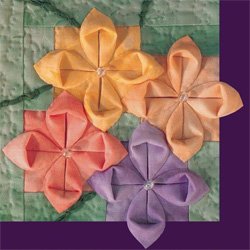Origami Quilts
Given that origami has been around for over a thousand years, origami quilts is a relatively new branch of origami. Here, paper is folded into units and many units join to form beautiful, planar mosaics. These can then be displayed on a tabletop or hung up against a wall.
Origami quilts may be considered a subset of modular origami. In modular origami, the models are usually polyhedra or stars. In contrast, origami quilts are flat and, in principle, can expand indefinitely. Because origami quilts are composed of many units joined side by side, they are reminiscent of tessellations. [Photo: origami quilt by R Gurkewitz.]

- the units are made of paper and therefore more affordable than traditional fabric quilts,
- the units are relatively easy to fold,
- the project can be made large or small depending on the children’s enthusiasm,
- the project promotes cooperation & working together, and
- the project can be incorporated into math and social study lessons.
[Photo: origami quilt made by Science Club for Girls – design by K Fan.]

- diagrams for origami quilts and Pascal’s Triangle
- Rosemary Lyndall Wemm blog has information on origami quilts
See samples from this book here.
- Mette Pederson has a spiral bound book which includes origami quilts
- Marcela Brina demonstrates the Blue-Eyed Grass Flower quit in this video
[Photo: origami quilt by H Verrill]

Fabric Origami Quilts
Recently, quilt-makers have started to fold fabric, origami style, to use in their quilts. The folded fabric can be added onto a quilt like an appliqué, or the folded fabric itself is a block within the quilt. Read more about fabric folding here.
To avoid confusion, we differentiate the two kinds of folding by using the term “origami quilts” to mean those quilts made of paper similar to modular origami. The term “fabric origami quilts” is used to mean true quilts which have origami-style folds within them.

Particularly noteworthy are the quilts made by Kumiko Sudo. She is an internationally acclaimed quilt and fiber artist and her books show an array of unique folds, some starting from a circular piece of fabric! See her books in: USA.
Fabric vs. Paper
What’s the difference between fabric and paper origami quilts? Obviously, fabric origami quilts are made with fabric while origami quilts are made with paper. However, there are consequences to this.
- Fabric is soft, pliable, and thick. Thus, it can only be folded into simple forms and often, the units need to be hand-sewn or tacked so that they maintain their folds.
- In contrast, paper can be folded into complex unit and do not need glue to maintain their creases.
- Fabric units are made to look beautiful, they add texture and dimensionality to a quilt. They do not have flaps and pockets because they will be sewn into the quilt.
- Paper units are designed to have flaps and pockets so that the units can be assembled without glue. Thus, the choice of fabric or paper will affect the overall design of the unit.
In short, units for fabric origami quilts are made so they look pretty and add value to a quilt. Units for origami quilts are made so that they can be made into a quilt.
Books about Origami Quilts and Fabric Folding
- Origami Quilts by Tomoko Fuse
- Origami Quilts by Louise Mabbs & Wendy Lowes
- Fantastic Fabric Folding by Rebecca Wat
- Simple Fabric Folding for Christmas by Liz Aneloski
- Fantasies & Flowers: Origami in Fabric for Quilters by Kumiko Sudo
- See Origami Quilt books





















